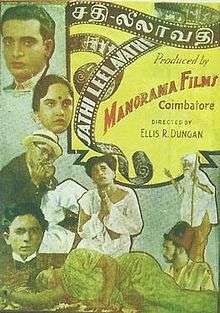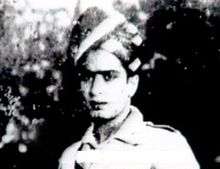Sathi Leelavathi (1936 film)
| Sathi Leelavathi | |
|---|---|
 Poster | |
| Tamil | சதி லீலாவதி |
| Directed by | Ellis R. Dungan |
| Produced by | Marudachalam Chettiar, Manorama Films |
| Written by | S. S. Vasan |
| Starring |
M. K. Radha M. S. Gnanambal M. G. Ramachandran T. S. Balaiya |
| Music by | Sundara Vadhyaar |
Production company |
Manorama Films |
Release date | 28 March 1936 |
| Country | India |
| Language | Tamil |
Sathi Leelavathi (English: Leelavathi, the wife) is a 1936 Indian Tamil-language film directed by Ellis R. Dungan and produced by the Coimbatore based Manorama Films.[1] This was the first film for M. G. Ramachandran and for Dungan as director. This was one of the first Tamil films to become the subject of a court case involving copyright violations.[2][3][4][5][6] No print of the film is known to survive, making it a lost film.
Plot
Krishnamurthy (M. K. Radha), a rich man living with his wife Leelavathi (M. S. Gnanambal) and a daughter in Madras, is lured into drinking, gambling and other vices by his friend Ramanathan (T. S. Balaiah) at a mock tea party arranged for this purpose; Ramanathan's collaborator is Rangaiah Naidu (M. G. Ramachandran), a corrupt police inspector. Krishnamurthy is lured by the wiles of Mohanangi (Santhakumari), a woman with loose morals. Infatuated by her, he promises to pay her ₹50,000.
Parasuram (P. Nammalvar), a good friend of Krishnamurthy, tries to reform him but his efforts yield no results. A moneylender who had lent a huge sum to Krishnamurthy to meet his lavish lifestyle issues a warrant for the recovery of his money and Krishnamurthy sinks into a deeper mess. In his drunken state, he finds fault with his wife and even accuses her of having an illicit relationship with Parasuram. When Parasuram visits Krishnamurthy to warn him about the warrant, Leelavathi advises him to leave as Krishnamurthy is not at home. Absent mindedly, Parasuram leaves his umbrella behind. Krishnamurthy comes home drunk, notices the umbrella, suspects that his wife is having an affair with Parasuram, beats her and rushes out with a revolver to shoot Parasuram. Meanwhile, Ramanathan sends his servant in the guise of Parasuram to steal the jewels of the Ekambareswarar Temple.
Krishnamurthy comes pursuing Parasuram; a shot is heard and a man lies dead. This sudden and unexpected calamity brings the drunken Krishnamurthy to his senses. Krishnamurthy thinks he has murdered his friend Parasuram, decides to escape and leaves his wife and child in the custody of his faithful servant Govindan. He goes to Ceylon where he leads a wretched life as a nameless labourer in a tea estate. Ramanathan now takes this opportunity to try to molest Leelavathi who rejects his illicit advances. Penniless, she goes with her servant and daughter and leads a poor but honourable life spinning the charkha. Meanwhile, Krishnamurthy, during his labour work, finds a treasure trove and gives it to his master; his master is pleased with his honesty and adopts him as his own son.
Years later, Krishnamurthy returns to Madras to be with his family, but is arrested for Parasuram's murder. Detective Srinivasan's (M. V. Mani) investigation reveals the malicious wiles of Ramanathan and Rangaiah; he supports this with evidence by producing the real Parasuram in court as an old man, who discloses his true self, thus proving Krishnamurthy's innocence. Krishnamurthy, acquitted by the court, reunites with his family. Ramanathan is sentenced to death while Rangaiah is convicted with seven years' rigorous imprisonment. Krishnamurthy's daughter marries Parasuram's son.
Cast

- M. K. Radha as Krishnamurthy
- M. S. Gnanambal as Leelavathi
- M. G. Ramachandran as Rangaiah Naidu
- T. S. Balaiah as Ramanathan
Crew
- Ellis R. Dungan - Director
- M. Kandasamy Mudaliar - Dialogue
- S. S. Vasan - Story
- Sundara Vadhyar - Lyrics[7]
Production
Sathi Leelavathi was based on a Tamil play named Pathi Bhakthi (lit. Devotion to the Husband) written by A. Krishnaswami Pavalar and starring K. P. Kesavan. It was staged by the Madurai Original Boys Company. M. Kandasamy Mudaliar wanted to make a film based on the play. Production started but soon stalled due to differences and K. P. Kesavan cancelled his contract. Mudaliar walked out of the production and started a new film titled Sathi Leelavathi based on a novel written by S. S. Vasan and serialised in Ananda Vikatan. Mudaliar's son M. K. Radha was cast as hero and an unknown (then) 19-year-old M. G. Ramachandran was cast as Police Inspector Rangayya Naidu. The film was produced by Marudachalam Chettiar of Coimbatore. Chettiar wanted Manik Lal Tandon to direct the movie and went to Calcutta to hire him. Tandon who was busy directing Nandanar, introduced Chettiar to Dungan and recommended Dungan be given the chance instead. Dungan was hired as director and the film was made. Some scenes were shot in location at Ceylon. The completed film was 18,000 feet in length.[2][7][8][9][10][11]
Release
Controversy
The film was released on 28 March 1936. Its release was delayed as it became the subject of a court case. Another film - Pathi Bhakthi - had been released in the same year based on the play of same name and starring K. P. Kesavan. The makers of Pathi Bhakthi sued Marudachalam Chettiar and Kandasamy Mudaliar for plagiarising their story. The case was resolved when S. S. Vasan, admitted in court that both Pathi Bhakthi (written by Krishnasamy Paavalar) and Sathi Leelavathi had been plagiarised from Mrs. Henry Wood's story Danesbury House.[2][8] The art magazine Aadal Paadal in its January 1937 issue appreciated the film for its social setting and praised it for its acting.[12]
Critical reception
Several new techniques introduced by Dungan were not understood by the audience and went unappreciated. Writing in the Silver Screen magazine on 1 August 1936, Pe. Ko. Sundararajan (journalist and writer of Manikodi movement) complained:[13]
| “ | The new methods of depicting emotions are not understood by our people. In Sathi Leelavathi Dungan showed the dancing girl as viewed by the inebriated hero. (In another scene), he showed the hero's fright by his twitching fingers and feet. These techniques not only helped the actors but showcased his (Dungan) talent as well. But as a lot of people know, our audience shouted that the lighting was not clear in the first case and the film was stuck in the second case. This shows the ignorance of our audience. | ” |
Availability
No print of Sathi Leelavathi is known to survive, making it a lost film.[14]
References
- ↑ Jeshi, K (7 December 2004). "Tunes and trivia". The Hindu. Retrieved 31 July 2015.
- 1 2 3 Pheroze L. Vincent (25 November 2009). "Romancing the reel". The Hindu. Retrieved 8 September 2013.
- ↑ Rajadhyaksha & Willemen 1994, p. 175.
- ↑ Baskaran 1996, p. 180.
- ↑ Baskaran 1981, p. 109.
- ↑ Muthiah 2004, p. 404.
- 1 2 Film News Anandan (2004). Sadhanaigal padaitha Tamil Thiraipada Varalaaru (in Tamil). Chennai: Sivagami Publications. pp. 28:7.
- 1 2 "Americans in Tamil cinema". The Hindu. 6 September 2005.
- ↑ Ramachandran & Rukmini 1985, p. 165.
- ↑ Narayanan 2008, p. 40.
- ↑ "Strong national flavour". The Hindu. 27 June 2008.
- ↑ Baskaran 2004, p. 47.
- ↑ Baskaran 2004, p. 39.
- ↑ Kantha, Sachi Sri (2 April 2013). "MGR Remembered – Part 7". Ilankai Tamil Sangam. Retrieved 25 April 2017.
Bibliography
- Baskaran, S. Theodore (1981). The message bearers: the nationalist politics and the entertainment media in South India, 1880-1945. Chennai: Cre-A.
- Baskaran, S. Theodore (1996). The eye of the serpent: an introduction to Tamil cinema. Chennai: East West Books.
- Baskaran, S. Theodore (2004). Chithiram Pesuthadi (in Tamil). Chennai: Kalachuvadu. ISBN 81-87477-75-X.
- Muthiah, S. (2004). Madras rediscovered. Chennai: East West Books (Madras) Pvt. Ltd. ISBN 81-88661-24-4, ISBN 978-81-88661-24-4.
- Narayanan, Arandhai (2008). Arambakala Tamil Cinema (1931-41) (in Tamil). Chennai: Vijaya Publications.
- Rajadhyaksha, Ashish; Willemen, Paul (1994). Encyclopaedia of Indian cinema. British Film Institute. ISBN 0-85170-455-7, ISBN 978-0-85170-455-5.
- Ramachandran, T. M.; Rukmini, S. (1985). 70 years of Indian cinema, 1913-1983. Chennai: CINEMA India-International. ISBN 0-86132-090-5, ISBN 978-0-86132-090-5.